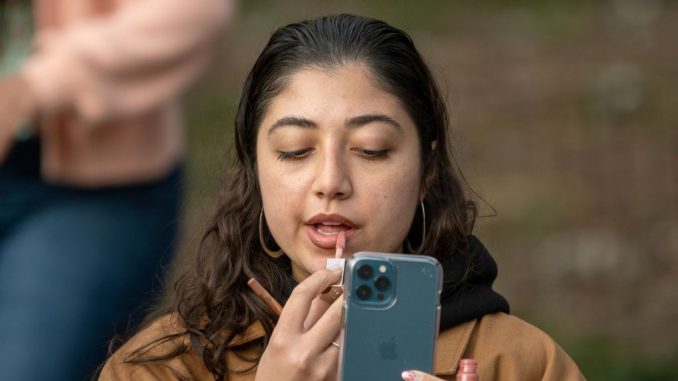
People spend an average of four hours a day making themselves look good, reveals a new study.
Regardless of age or gender, people spend a sixth of their lives enhancing their beauty, suggests the research.
And the most likely culprits are social media users striving for likes. Racking up the hours on social media was the strongest predictor of passing a lot of time in the mirror, according to Russia’s Higher School of Economics (HSE).
Those who use apps to aim for unrealistic beauty standards, and who fear getting fewer likes on their posts, were found to spend the most time on their looks. In the largest study of its kind, HSE researchers asked more than 90,000 people, across 93 countries, how much time they spend enhancing their physical appearance each day.
They discovered men and women devote around four hours a day applying make-up, grooming hair, picking outfits, practicing hygiene, exercising and following specific appearance-enhancing diets versus those geared to just staying healthy.
The old spend as much time preening as the young. And those in early romantic relationships tend to spend more time on their looks than married people or long-term partners.
Women from nations and cultures with pronounced gender inequality and traditional gender attitudes commonly invest more time and effort on their looks.
This contrasts with those living in countries in more equal societies.
Moreover, people focus extra time on beauty enhancement if they come from individualistic cultures where personal accomplishments are valued over collective success.
Professor Dmitrii Dubrov, of the HSE Centre for Sociocultural Research and a co-author of the study, said: “We were able to collect data on almost 100,000 people across a very large sample in terms of age, education and income level, including many participants from non-industrial countries for which we had no previous data.”

Several evolutionary theories were tested by the team, including the belief people work to look good in a bid to boost their luck finding a mate.
This was supported by participants in the early-stages of love spending more time on their appearances than long-term partners.
Another theory held individuals with a history of serious pathogenic disease spend extra time on their looks to mask traces of illness. As a result, researchers previously hypothesized people from nations at high risk of pathogenic disease were generally more likely to clock similar hours.
People did spend more time working on their looks if they had a disease. Living in a high-risk nation did not, however, inevitably result in more time spent preening.
The findings, published in the journal Evolution and Human Behavior, suggest that this could be due to better healthcare even in countries that once struggled with severe infections.
Dubrov added: “We were able to collect data on almost 100,000 people across a very large sample in terms of age, education and income level, including many participants from non-industrial countries for which we had no previous data.
“In this paper, we tested five existing theories that shed light on people’s attractiveness-enhancing behaviors. These theories are complementary rather than mutually exclusive.
“We confirmed certain assumptions and came up with some interesting and less expected results.
“This study is an important step in evolutionary and sociocultural research that will allow a better understanding of human psychology and our attitudes towards beauty.”
Produced in association with SWNS Talker
Recommended from our partners
The post People Spend This Many Hours A Day Making Themselves Look Good appeared first on Zenger News.
